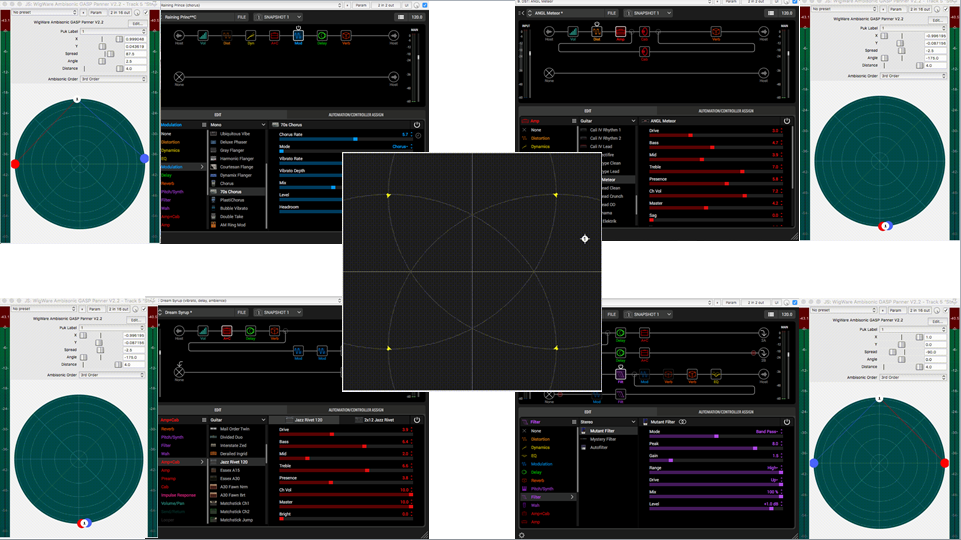This poster represents work done by Undergraduate Research students: Emma Fitzmaurice, Beth Mansfield, Tom Nash and Harry Dale, with supervision from Duncan Werner and Bruce Wiggins.
Research to identify further developments of the GASP system
for enhanced functionality

The GASP research project (Guitars with Ambisonic Spatial Performance) is an ongoing University of Derby project based at Markeaton Site, where our interest in ambisonic algorithmic research and guitar sound production is combined with off-the- shelf hardware and bespoke software to create an ambisonic based ‘immersive’ guitar sound system. It’s an innovative audio project, fusing the musical with the technical, combining individual string timbralisation with ambisonic surround sound. Consequently, it also facilitates an artistic musical project, providing alternative new experimental surround sound production techniques for the guitarist and music producer.
The GASP research project was originally intended as a small scale project to exploit our ambisonic lab at Markeaton site for student experimentation; however the ambisonic (surround sound) output will also work in large format theatre/concert systems. Additionally, the audio may also be ‘downmixed’ (converted) to work with traditional stereo sound installations or home stereo sound systems, and also personal playback over headphones i.e. stereo or binaural, or google 360 virtual reality (VR) sound via web streaming.



Our Ambisonic Guitar System operates across two individual but interconnected computers. One computer (Mac Pro) is associated mainly with timbral (Helix) and spatial (Wigware) processing; the other computer (Imac) runs the associated control software. The software routing configuration work was mainly done by previous URSS recipient Emma Fitzmaurice.
Aims and Objectives
Previous funding through URSS has enabled significant development of the GASP research project, with the 2019 funding focussing on the development of some specific attributes, including:
- Timbral Morphing – research into innovative ways for the sound morphing of guitar sound presets from one timbre to another.
- The presentation at University of Derby ‘Sounds in Space’ symposium in June 2019, and preparation for ‘Innovation in Music’ international conference at the University of West London in December 2019.
- Documentation of system set-up diagrams and interconnections.
- Control system programming of Behringer FCB1010 MIDI Foot Controller, implementing UnO Control chip



We generated a diagram displaying the general set up of the GASP system, in room MS218a. The purpose of this diagram is to help explain how the system works, showing what role each component has, as well as for our own benefit for when the system may be transported and rebuilt. The set up in the diagram can be replicated in almost any space.



In order to change timbral or spatial patches, an FCB1010 footswitch is used to send MIDI messages to the iMac running Ableton. The FCB1010 is customisable and can store up too 100 presets, although it can be awkward to program initially.
We discovered a company called UnO have developed a chip and software designed specifically for the FCB1010 which allows very easy programming of the board, and the set up is saved on the computer so it can easily be recovered. This allowed us to program the footswitch exactly how we wanted it within a few minutes, rather than an hour or two.
One of our stated objectives was to research and implement what we have termed ‘Timbral Morphing’. Our first efforts centred around investigating software called ‘pMix’. This is open source software that allows morphing between preset parameters of audio plugins, therefore able to smoothly blend timbres.
However we found limitations with pMix, in particular it only supports VST plugins, and Helix is in VST3 format. We found a workaround where audio can be blended from one timbre to another using real-time mixing between sounds. However, this is computationally intensive and so other solutions are sought for future work.





We recently presented our GASP research project to an audience at the University of Derby symposium “Sounds in Space’ in June 2019. This event involved both a formal presentation to delegates followed by a live demonstration of the system with a number of guitarists performing in a wide variety of styles.
We have been accepted to present a paper and demonstration ‘Development of an Ambisonic Guitar System’ at the ‘Innovation in Music’ international conference at the University of West London in December 2019. The outcome of this conference will lead to the publishing of our paper as a book chapter with Routledge academic publishers.


